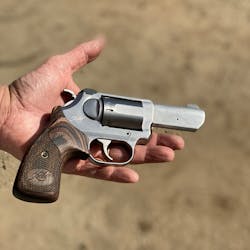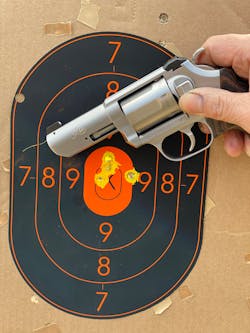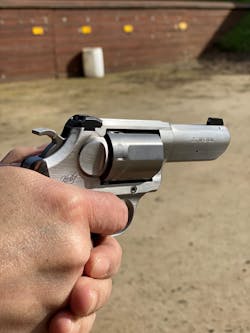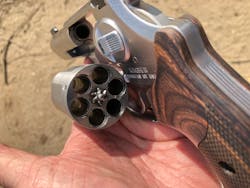One More in the Chamber: Review of the Kimber K6S Revolver
I tested the Kimber K6S 3”, a stainless .357 revolver with a 3” barrel, walnut grips and a double or single action (DA/SA) trigger. It proved to be accurate, intuitive, and a perfect all around revolver.
If anyone hasn’t noticed, the revolver is back. It may have something to do with the ammunition innovations over the past few years, or consumers responding to more prohibitive gun regulations or a combination of several factors. Whatever it is, most of the major gun manufacturers have entered at least one new revolver in the past five years.
Kimber’s initial launch of the DAO (Double Action Only) models was an outstanding success. They followed up with DA/SA models in 2”, 3”, and 4”. I personally like 3” barrel revolvers, so I chose this happy medium for testing.
“I won’t carry a gun unless I can print bullets reliably into the sinus cavity of a target at seven yards. You should not either.”
The 3” K6S weighs 25.1 ounces, unloaded. This is the sweet spot for the powerful .357 cartridge. I get to shoot plenty of pocket revolvers, and although I prefer the super lightweight ones around 12 to 15 oz, they can produce some punishing practice sessions. The Kimber is heavy enough to mitigate some recoil and light enough to carry anywhere. Most of the lightweight revolvers are five-shot; the K6 series of revolvers hold six.
I’ll talk about the performance in a bit, but my first impression has been a lasting one throughout this test. This gun balances in the hand well. It isn’t front heavy. Front heavy guns are tiring to shoot after a while. It doesn’t have a lot of weight in the hand, which would make it less recoil resistant. It’s just right.
Let’s go on with our comparison.
Both the SP 101 and the Model 360 are .357 Magnum, but they are five-shot. Despite the extra round, the K6 is about the same width. That is, the average J Frame, like those in revolvers like the Model 360, is about the same as the K6. My Model 38, another J Frame, is 1.310” wide at the cylinder. The K6 is 1.39” wide.
How is a six-shooter the same width as a five-shot? If you hold a revolver like you’re going to shoot it, the center of each chamber forms a pentagon. Since a pentagon really doesn’t have parallel sides, engineers can’t have the sides minimized or flattened like they can with a hexagonal pattern. Obviously, there is a physical limit to this, because the walls have to be a certain thickness in order to contain the pressure of the cartridge. Kimber shrank the size of the cylinder by making the parallel sides of the hexagonal shape thinner, without thinning the chamber walls. It is efficient engineering.
The K6 has countersunk chambers, an unusual design for this genre of revolvers. The chamber part of the revolver is where the cartridge is placed in the revolving cylinder. Most of them are simple: They are precision drilled holes. When a rimmed cartridge is inserted, the rim prevents it from going any further. On non-countersunk chambers, the rim sticks out. Kimber has drilled a recess so the cylinder accommodates the entire cartridge, which adds a little more to the manufacturing process.
What’s the advantage? Generally, there is none unless there is a catastrophic ammunition failure like an overpressure. This is rare and modern manufacturing has all but eliminated it. The countersunk chamber does a better job of containing overpressure.
The ejector is not a full-length rod, which is consistent with compact revolvers. We didn’t find this to be a problem, especially given the fact that the chamber walls were very smooth. On the range, the spent brass kicked away cleanly, even after getting it nice and dirty during my range session.
Kimber uses a button type cylinder latch, which is much smoother and more intuitive than similar designs. It completely excelled in getting back in the fight, and cylinder lock-up was positive. The ejector rod has a full under-barrel shroud, which also aided in full lockup of the action.
When the K6 first came out, I shot the DAO trigger, 2” version. On this model, the hammer is completely internal. Everyone that picked it up noticed the smooth trigger, which was around 10 pounds. I noticed right away the ease in which it threw .357 rounds at the target. The K6S I tested here has the 3” barrel, giving a good jump in velocity and therefore performance. And it feels better.
This brings up my only criticism of the K6, and the same could be said for many other revolvers. When one “milks” the trigger, the cylinder completely unlatches, as it should, but it loses its index. I was able to milk the trigger enough to get it to settle between chambers. The good news is the fact that a simple DA pull gets it right back to indexing on the chamber and firing. This is a non-issue when it comes to reliability, but it’s something people should know.
I won’t carry a gun unless I can print bullets reliably into the sinus cavity of a target at seven yards. You should not either. With the K6S, I could make all the holes touch at seven yards (I put them into almost the same hole). In fact, many shooters can do the same thing I did consistently. A few times around the cylinder re-proved my first impression when the K6 debuted. This is the revolver to have in a gunfight.
I like the walnut grips and checkering. It works well in an IWB holster against the body without being uncomfortable. If I could exercise my preference, I like a little more recess behind the trigger guard.
Why would a person choose the K6 over something like an auto? First, the .357 cartridge can do almost anything. Since it does not have to maintain a consistent recoil impulse, shooters can train with extremely light loads, and carry loads that can punch through vehicle doors much better than common duty cartridges. There are .357 specialty loads, like snake loads, and even combinations for last-ditch protection against game hazardous to one’s well-being.
As far as duty cartridges are concerned, there are offerings like Hornady’s Critical Duty, which push a 135-grain Flex Lock bullet almost 1,300 fps. The .357 cartridge, one of the older handgun cartridges in the business, never has to be pushed hard to deliver Mach 1 speeds.
The K6 can be placed in saltwater duty and HAZMAT areas, where some environments favor stainless steel. This is not much of an issue anymore with modern materials and coatings.
A lot of the arguments in favor of carrying one over the other comes down to simple preference. If you need a handgun whose projectiles have a little more penetration capabilities and considerably more flexibility, the K6 is one of the best choices out there.

Officer Lindsey Bertomen (ret.), Contributing Editor
Lindsey Bertomen is a retired police officer and retired military small arms trainer. He teaches criminal justice at Hartnell College in Salinas, California, where serves as a POST administrator and firearms instructor. He also teaches civilian firearms classes, enjoys fly fishing, martial arts, and mountain biking. His articles have appeared in print and online for over two decades.






